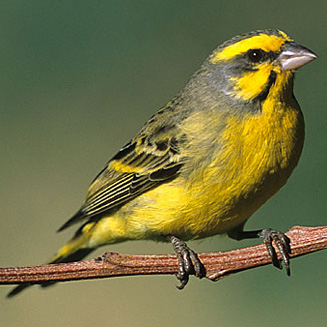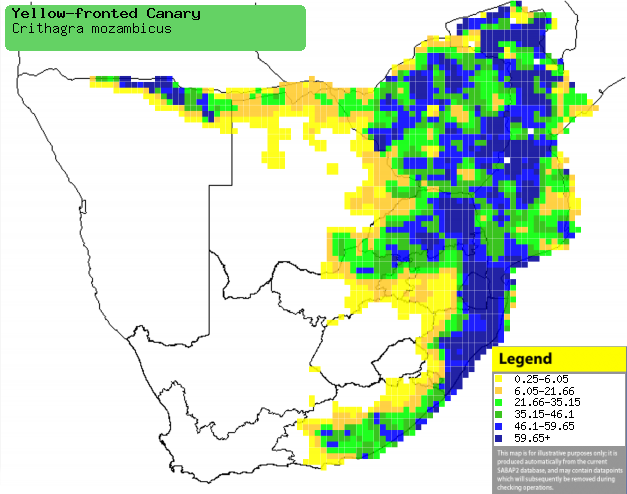|
Crithagra mozambicus
(Yellow-fronted canary, Yellow-eyed canary)
[= Serinus mozambicus]
Geeloogkanarie [Afrikaans]; Unyileyo [Xhosa]; umBhalane [Zulu];
Kamukombo Nsense/Nsense [Kwangali]; Toere (generic term for canaries and
siskins) [South Sotho]; Mbalane [Swazi]; Manswikidyani, Risunyani, Ritswiri
[Tsonga]; Mozambiquesijs yellow-fronted [Dutch]; Serin du Mozambique [French];
Mossambikgirlitz [German]; Canário de Moçambique [Portuguese]
Life
> Eukaryotes >
Opisthokonta
> Metazoa (animals) >
Bilateria >
Deuterostomia > Chordata >
Craniata > Vertebrata (vertebrates) > Gnathostomata (jawed
vertebrates) > Teleostomi (teleost fish) > Osteichthyes (bony fish) > Class:
Sarcopterygii (lobe-finned
fish) > Stegocephalia (terrestrial
vertebrates) > Tetrapoda
(four-legged vertebrates) > Reptiliomorpha > Amniota >
Reptilia (reptiles) >
Romeriida > Diapsida > Archosauromorpha > Archosauria >
Dinosauria
(dinosaurs) > Saurischia > Theropoda (bipedal predatory dinosaurs) >
Coelurosauria > Maniraptora > Aves
(birds) >
Order: Passeriformes > Family: Fringillidae
 |
 |
|
Yellow-fronted canary, Kruger National Park, South
Africa. [photo Trevor Hardaker ©] |
Yellow-fronted canary, Rustenburg, South Africa. [photo Johann Grobbelaar
©] |
Distribution and habitat
Occurs from Senegal to Ethiopia south to southern Africa,
where it is common to locally abundant across Mozambique, Zimbabwe, Swaziland,
eastern South Africa and northern Namibia, while more scarce in Botswana, the
Caprivi Strip (Namibia) and South Africa's eastern interior. It generally
prefers savanna, especially Acacia, Burkea (Burkea africana),
miombo (Brachystegia) and riverine woodland as well as man-made
habitats such as fallow cropland, parks, gardens and edges of plantations.
|
 |
|
Distribution of Yellow-fronted canary in southern
Africa, based on statistical smoothing of the records from first SA Bird
Atlas Project (©
Animal Demography unit, University of
Cape Town; smoothing by Birgit Erni and Francesca Little). Colours range
from dark blue (most common) through to yellow (least common).
See here for the latest distribution
from the SABAP2. |
Predators and parasites
It has been recorded as prey of the following animals:
Movements and migrations
Resident and largely sedentary although it may
make local movements, especially along the arid edge of its
distribution.
Food
It mainly eats seeds, flowers, leaves, nectar and insects,
doing most of its foraging on the ground often along with other canaries and
waxbills. The following food items have been recorded
in its diet:
- Plants
- seeds
- Helianthus (sunflowers)
- Chenopodium glaucum (Fat-hen)
- Bidens pilosa (Common blackjack)
- Ursinia nana (Marigold)
- Trema orientalis (Pigeonwood)
- alien plants
- Pinus (pine trees)
- Casuarina (beefwoods)
- flowers of Combretum microphyllum (Flame climbing bushwillow)
- flowers and leaves
- Hibiscus
- Tagetes minor (Khakiweed)
- leaves
- Lycium ferocissimum (Snake-berry)
- Acacia karroo (Sweet thorn)
- nectar
- Aloe
- A. marlothii (Mountain aloe)
- A. ferox (Bitter aloe)
- A. greatheadii (Spotted aloe)
- Erythrina latissima (Broad-leaved coral-tree)
- Insects
Breeding
- Monogamous, usually widely-spaced solitary nester, although it may form
loose colonies with three adjacent trees each with a nest.
- The nest is built mostly or entirely by the female, consisting of a
small deep cup of tendrils, bark fibres, leaf petioles, dead seedheads of
asteraceous plants, dry grass and sometimes pieces of string, bound with
spider web and lined with rootlets and plant down. It is typically placed in
the fork a bush, tree or creeper, roughly 1-8 metres above ground.
- Egg-laying season is from September-April, peaking from December-March.
- It lays 2-5 eggs, which are incubated solely by the female for about
13-15 days while the male feeds her regularly at the nest.
- The chicks are brooded solely by the female who is handed food by the
male for both herself and her young, who are later fed by both adults. They
eventually leave the nest after about 16-24 days, remaining dependent on
their parents for food for some time.
Threats
Not threatened although it is a popular cage bird, but it
is at least common in protected areas.
References
-
Hockey PAR, Dean WRJ and Ryan PG 2005. Roberts
- Birds of southern Africa, VIIth ed. The Trustees of the John Voelcker
Bird Book Fund, Cape Town.
|
